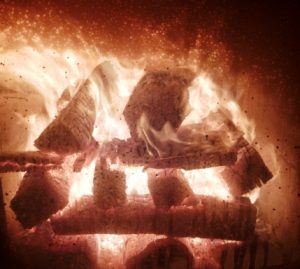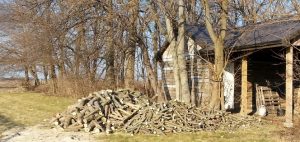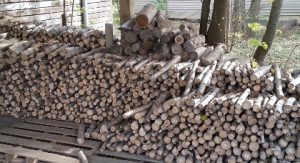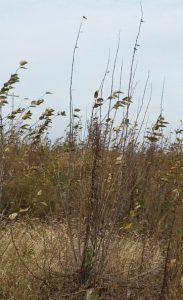 I’d like to welcome all returning (and new prospective) pyromaniacs to the 2nd installment of my blog on how to heat your home with wood. Now that we have kindling out of the way, the next item we need to talk about is firewood. Having a few acres in the country in Central Illinois doesn’t automatically come with a woodlot (or trees in most cases), so you have to be a bit creative. Of course, you could buy your firewood, but really, where is the sport in that?? We are all about sport at our house … generally of the “go big or go home” variety.So, how do you increase your sport quotient? The first thing you do is till up about 1/5 of an acre of your property and begin to practice short-rotation coppicing. <begin digression> In case you are not familiar with the term, coppicing is a traditional method of woodland management which takes advantage of the fact that many trees will quickly sprout new branches from the remaining cut trunk. In a coppiced woodlot, trees are cut down after a certain number of years (5 in our case). The stumps grow branches, and those branches turn into trees which can then be cut down again in 5 years. This process can be repeated multiple times. People have been coppicing firewood for many thousands of years.
I’d like to welcome all returning (and new prospective) pyromaniacs to the 2nd installment of my blog on how to heat your home with wood. Now that we have kindling out of the way, the next item we need to talk about is firewood. Having a few acres in the country in Central Illinois doesn’t automatically come with a woodlot (or trees in most cases), so you have to be a bit creative. Of course, you could buy your firewood, but really, where is the sport in that?? We are all about sport at our house … generally of the “go big or go home” variety.So, how do you increase your sport quotient? The first thing you do is till up about 1/5 of an acre of your property and begin to practice short-rotation coppicing. <begin digression> In case you are not familiar with the term, coppicing is a traditional method of woodland management which takes advantage of the fact that many trees will quickly sprout new branches from the remaining cut trunk. In a coppiced woodlot, trees are cut down after a certain number of years (5 in our case). The stumps grow branches, and those branches turn into trees which can then be cut down again in 5 years. This process can be repeated multiple times. People have been coppicing firewood for many thousands of years.
We chose to plant hybrid poplars as our coppice “crop” … willow is another viable option. Now I can hear you thinking “poplar isn’t good firewood … that’s a softwood, and a sappy one at that.” Ding! You are absolutely correct. However, we are lucky that our fireplace, also known as a Masonry Heater (the topic of my upcoming 3rd blog post, and also the subject of this week’s “What we are Reading” section) can not only burn any kind of wood (from 100% hedge to 100% poplar), but the softer and quicker burning woods are even a bit better than a longer burning wood like Osage Orange. The thing to remember about firewood is that, by weight and moisture content, all wood has pretty much the same BTU. So, the BTU in 50 pounds of poplar is about the same as 50 pounds of hedge … it just takes up a lot more room in the firebox. <end digression>
After your 1/5 acres is ready to go, stick 255 hybrid poplar cuttings (small branch cuttings with a few buds on them, about 8″ in length) into the dirt on approximately 6′ centers. And, let me tell you that it’s very important for that spacing to be correct. If it’s too small you won’t be able to mow in between the rows with your large mower deck (which has the potential to make maintenance the first few years a serious pain — not that I have any direct experience with this, no sir!). If it happens to be a drought year … and really, how bad would your luck have to be to have that happen .. you’ll need to drag some drip irrigation out to water your cuttings so they don’t all die. We lost all 255 of our 2nd year planting, but managed to save the entire first year planting with veeeeeeery long rows of drip irrigation, and many, many, many hose junctions (our nearest water source was 450′ away). We planned on 4 plots so that we could harvest one plot each year (and have a gap year) and have a steady supply of firewood. Subsequent plantings are free, since you can take cuttings from the previous years’ trees to propagate the trees. Here is a photo of one of our plots at the end of the 3rd year. The trees are about 10′ tall. At this point they don’t look too intimidating.

After 5 years (harvest time!), they are quite a bit more overwhelming (sorry, my photo isn’t very good, but these are probably 25′ tall and have a diameter of about 8″ near the ground).

It helps in the early years if you trim off the lower branches so there is less limbing to do when you cut them down. Here is the 1st year plot after cutting down the trees and hauling them over to the woodshed. There are a lot of smaller limbs to be chipped still.

After you drag all 255 trees over to the woodshed, you’ll need to buck them (cut them to length). Because we are particular about things (according to several of our acquaintances), we wanted them exactly 20″ in length so they would fit perfectly in our firebox. You can’t get that level of quality control when you purchase firewood. After bucking you are left with a scarily big pile of wood to split, plus a nice stack of the smaller limbs. A rule of thumb for the best burning is to split your wood so that no piece has a larger circumference than a beer can (and it’s an excuse to have a cold beverage handy at all times for comparison while working with power tools) — make that a soda can instead! Safety first!


The really great part of a system like this is that you get to do it every single year! YAY! Oh, wait, I almost forgot a fun follow-up task. Once your coppiced plot has re-sprouted, you’ll want to trim each trunk back to the strongest leader over the winter. This one trunk has about 25 limbs … multiplied by 255 … I think our hands are going to fall off! At least the gloves will provide a bit of padding against blisters. Let me know if you need some hand strengthening exercises .. I can hook you right up.



